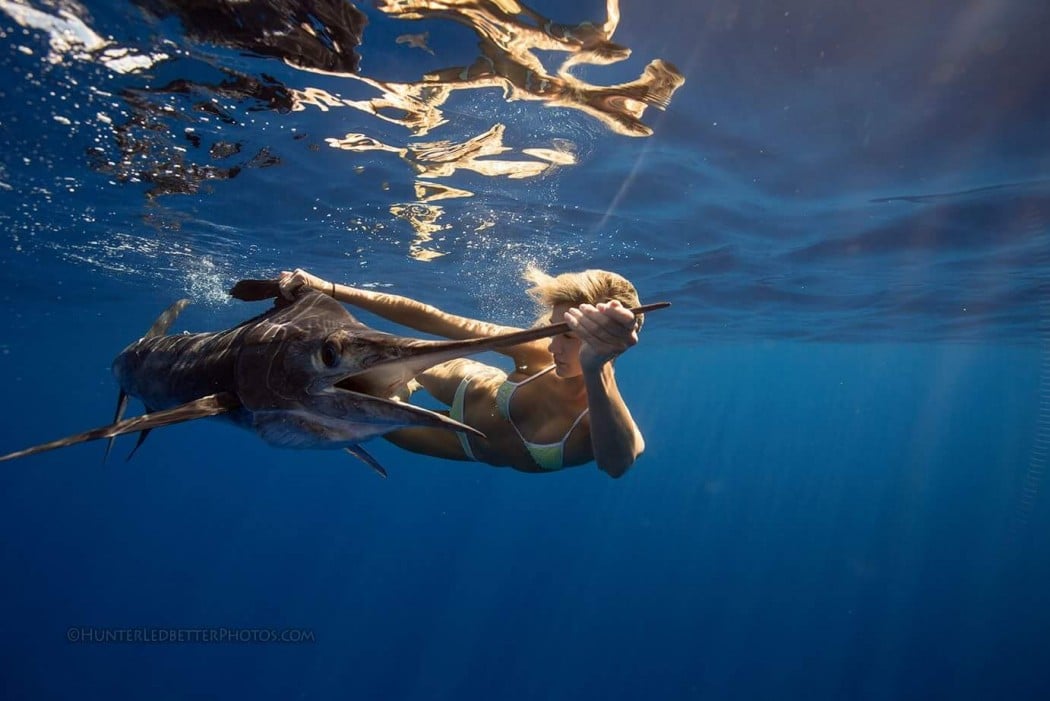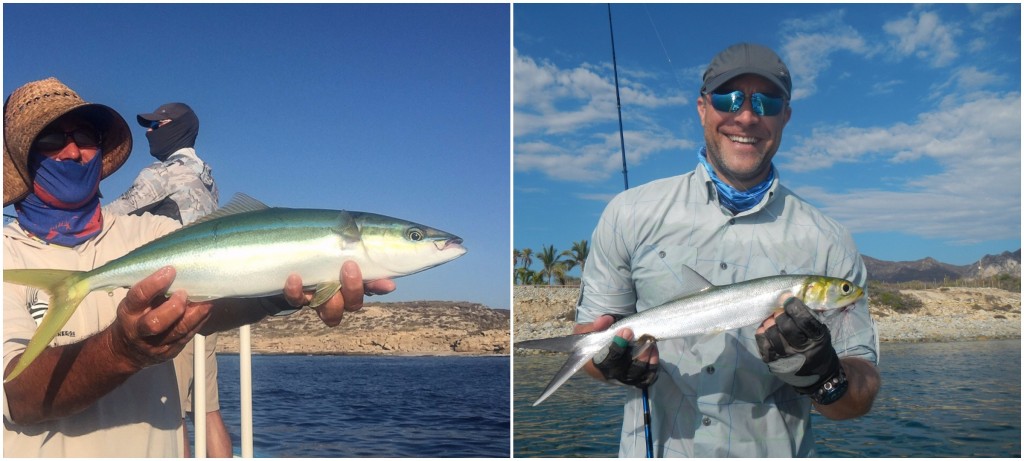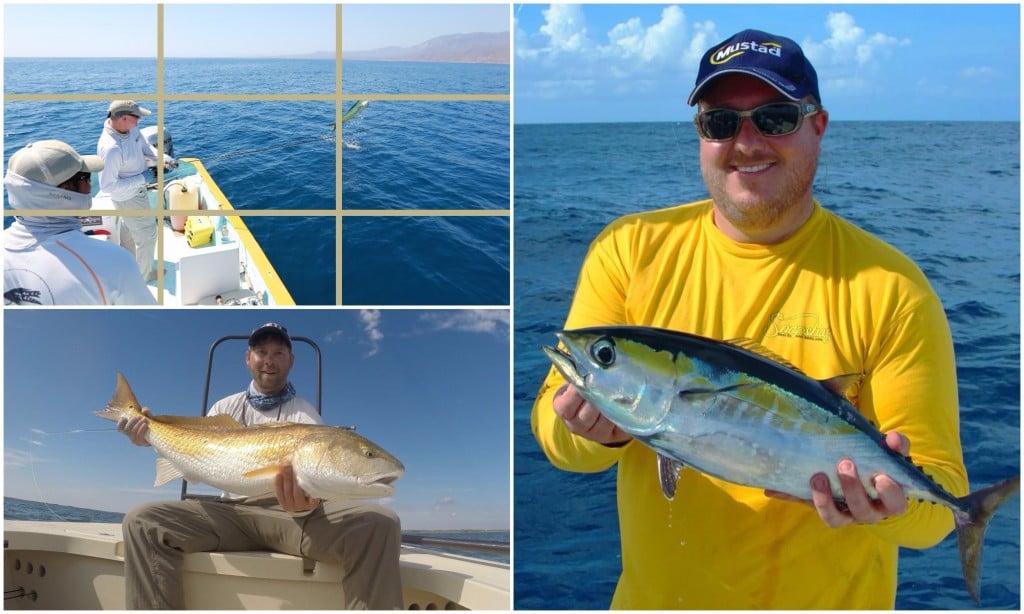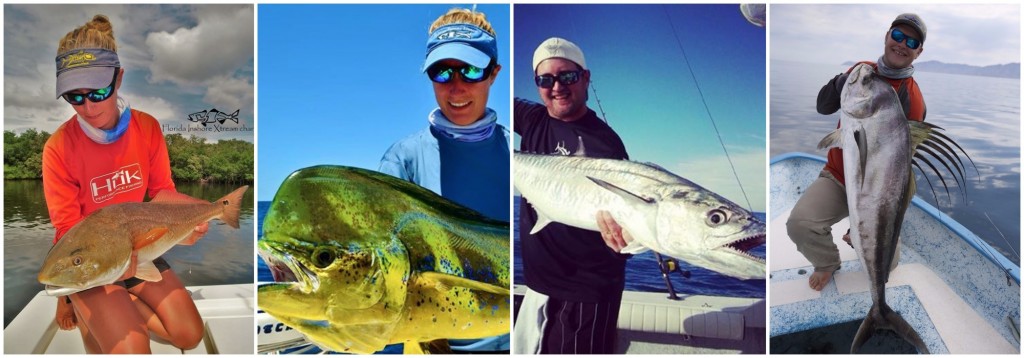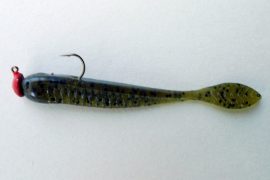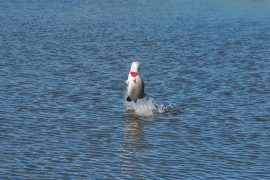Brooke Thomas in-water release of her first Striped Marlin, caught aboard Blue Sky Cabo.
Photo Credit: Hunter Ledbetter
We recently covered how to take better hunting photos and immediately people wanted to know how to take better photos of their fish. Here, we rehash a few of the broader points from the previous article, but then dive into specific tips for photographing your trophy fish.
How many times have you come home from a great trip and been really excited to look at the photos, only to be underwhelmed? The photos don’t do the day justice and the fish just don’t look as colorful or as big as you remember. There are some simple tips that will take your fish photography skills to the next level, you will be impressed with the results and proud to show off your photos. Most of this article covers getting the perfect “grip and grin” photos of your fish but at the end we will also cover some fun alternate ideas.
It’s not the camera
Having a camera is obviously the most important part. Without one you won’t even be able to take an average photo, much less a great one. What camera to bring is becoming less important all the time. Consider where you fish, what you have room for, and what features you want. Luckily, with the huge leaps made in digital photography, bringing along quality gear is easier than ever.
Most of the cell phones that we all carry have a good camera, just make sure to wipe the lens with a clean cotton shirt or microfiber cloth. A dirty lens will result in images that are blurry and cloudy. A small rugged point-and-shoot camera will fit in just about any pocket and take great pictures. Many are waterproof and offer more control over your settings in addition to better low-light performance. A DSLR will give you even more user selectable settings, the ultimate in manual control, much faster shutter response, and perform better in low light. The DSLR is a great choice if you like the manual control and intend to make larger prints or use the photos for editorial, but it is the bulkiest option. Whatever you choose make sure you are comfortable with the operation. At a minimum make sure you know how to set the camera to AUTO. If you will be adjusting any camera or lens setting, spend some time practicing!
The bottom line, any camera you bring will take amazing photos as long as you are mindful of a few of these details.
Look your best
Photo Credit: Daniel Cohen
The fisherman is usually the second most prominent subject in the photo, take a second to get yourself ready.
- We love our hats and sunglasses, but they are practically a disguise! When posing with your trophy tip your hat up a little bit or remove it and consider taking off your sunglasses.
- If it is hot or cold out you may have some other articles of clothing to deal with. If you have a face mask or neck gaiter it should be pulled down all the way or removed.
- Wear sunscreen, in addition to being important for your safety and health you don’t want a sunburn in your photo.
- Using a flash in bright daylight can help light the anglers face so that a hat wont cast a harsh shadow.
Composition, composition, composition
Photo Credit: Clockwise – Daniel Cohen, 5 STAR Sportfishing Charters, Asheville Fly Fishing Company
Blue sky, clear water, scenic coastline, and idyllic river banks are all part of the reason we fish. We all have a passion for being outside and in nature. Regardless of your plan to keep your catch or release it, take the time to compose your shot when your catch is still fresh. Composition has a huge impact on the quality of your image, here are some tips.
- The sun should be behind the camera. Luckily a lot of fishing is at sunrise and sunset so you can take advantage of the best light. Cloudy days are great for photos too but too much direct sun can make for harsh shadows. Use the camera flash on a sunny day to light up the shadows as best you can.
- If possible your silhouette should be against the skyline. A busy background will take away from the subjects of the photo (the angler and the fish).
- Don’t be too wide or narrow with your framing. Capture some of the natural surrounding but focus primarily on the angler and the catch.
- Obey the rule of 3rds. Your most interesting subjects should be on the ⅓ grid lines.
- Consider where the angler will pose. If you are on a boat, the best place for the angler is against the stern rail holding the fish high and SLIGHTLY away from your body. Do NOT straighten your arms to make the fish look bigger, you can’t really fool anyone that way.
- A slightly low angle is best. Keep the lens at or below eye level with the fish.
Pose your Fish
Photo Credit: Left to right – Florida Inshore Xtream Charters, Florida Inshore Xtream Charters, Fired Up Fishing Charters, Daniel Cohen
With a little care, your trophy catch can look its best. Posing your fish is about showing off its size, natural color, and any specific characteristics.
- You want the fish to be as vibrant and natural looking as possible. That is how you will remember your catch so that is what the camera should record. Take the picture soon after catching the fish and rinse or hose off any dirt and blood. Be mindful of gaff marks. Wet the fish to get the most vivid colors possible.
- In the classic grip and grin pose the fish should have a posture with the head slightly forward and down. This means the tail will be higher than the head and moving slightly away from the camera.
- Angle the fish so the side catches the sun and really lights up. Usually that means tipping the dorsal fin slightly towards you
- Consider your hand placement, try not to cover the eyes or have your fingers inside the gill plate facing the camera. One hand near the tail, one hand by the pectoral or under the gill plate closest to your body.
- Some fish are easier to hold and/or will look better held head up tail down. In this case use one hand to push the tail out a little to catch the sunlight.
Think outside the boat
Photo Credit: Left to right – Daniel Cohen, Copper River Salmon Charters, Gary Bulla Saltwater Fly Fishing, Florida Inshore Xtream Charters
The tips above are just a starting point, a good way to achieve some classic shots. Get creative , be sure to try some new things as well. With the move to digital “film is cheap” so take a lot of pictures and keep the few good ones. Here are a few ideas to get you thinking about alternative shots.
- An underwater camera can add a lot of options for your outdoor photography. An underwater point and shoot is available from most of the camera manufacturers and there are several waterproof action cameras that are reasonably priced as well.
- Fish live in the water not on land, to photograph them in their natural habitat you can get in the water with them. Stand anywhere from ankle to waist deep and hold the fish right at the surface. Also, if you plan to release the fish, it has a higher likelihood of survival if you never take it out of the water.
- Have your guide or a buddy take pictures of you while catching the fish. Salmonoids, billfish, dorado, tarpon, and many other species will jump when hooked and those can make for some very dramatic photos. An underwater shot of the hooked fish coming to the boat will tell the story in a dramatic way.
- Above or underwater pictures of the fish being released are proof that your catch swam away and make a great statement about your commitment to conservation.
- If your fish has a notable characteristic like the comb on a roosterfish, the sail on a sailfish, the mouth of a tarpon, or the teeth of a barracuda try and find a way to feature that one unique part.
- Lastly, some fish are so colorful it might be a good idea to get a close up of the head, eye, fins, etc…
About Fin & Field
#FinandField #FYNA #DreamBig2016
Fin & Field is all about finding your next adventure. We’re working hard to provide the most comprehensive listing of services, reviews, and far reaching community available to help you take the guesswork out of planning your next adventure.
We believe in the ethical pursuit of hunting and fishing adventures and support taking from the land only what you can use and leaving it in better shape than you found it.
Tight Lines & Happy Hunting!
Visit us at www.finandfield.com

